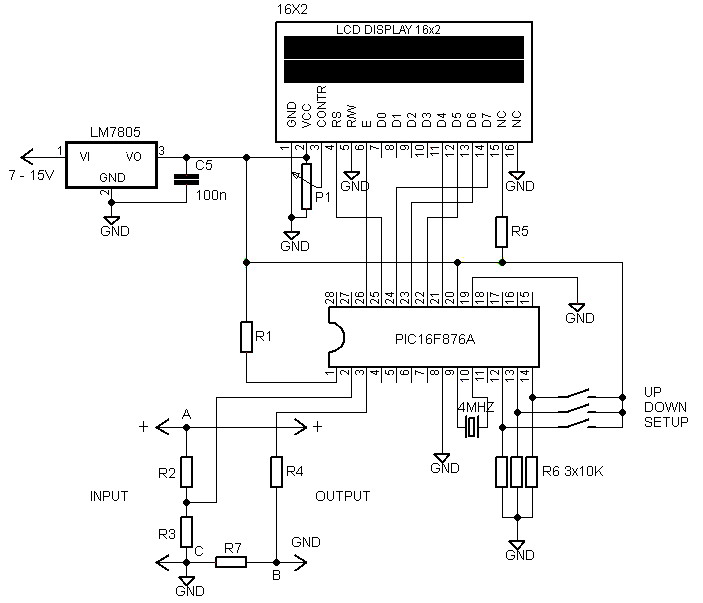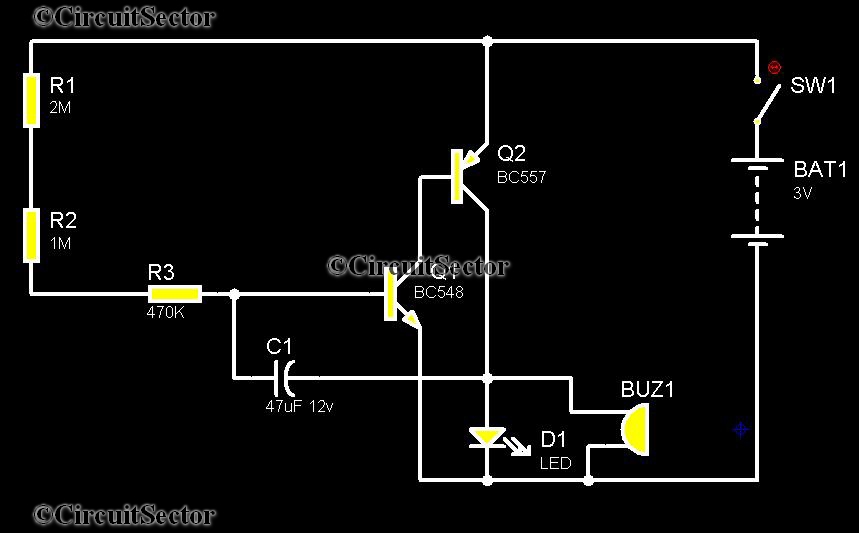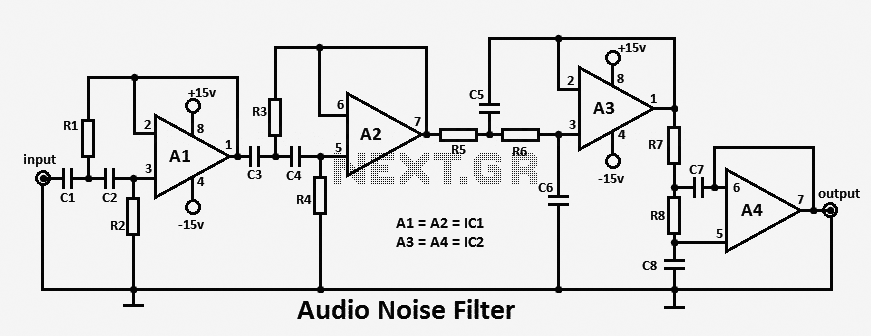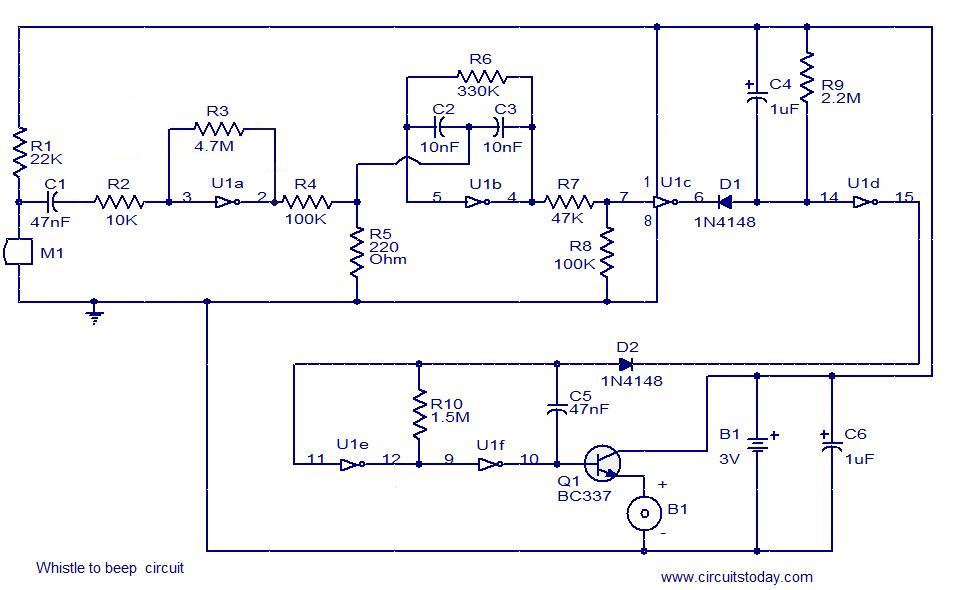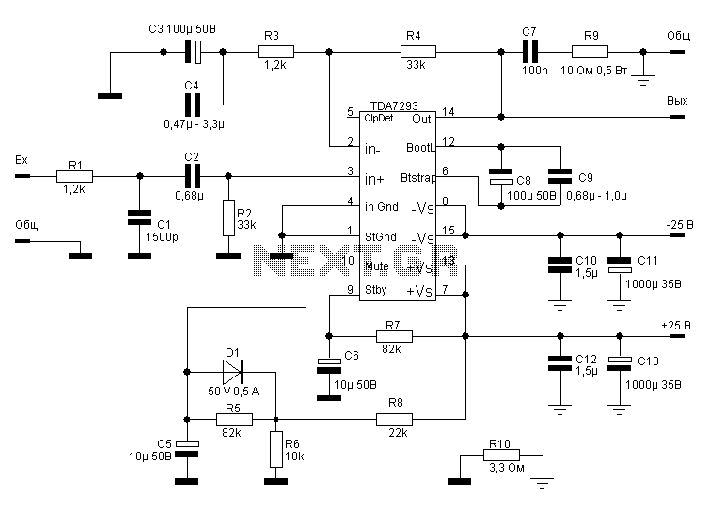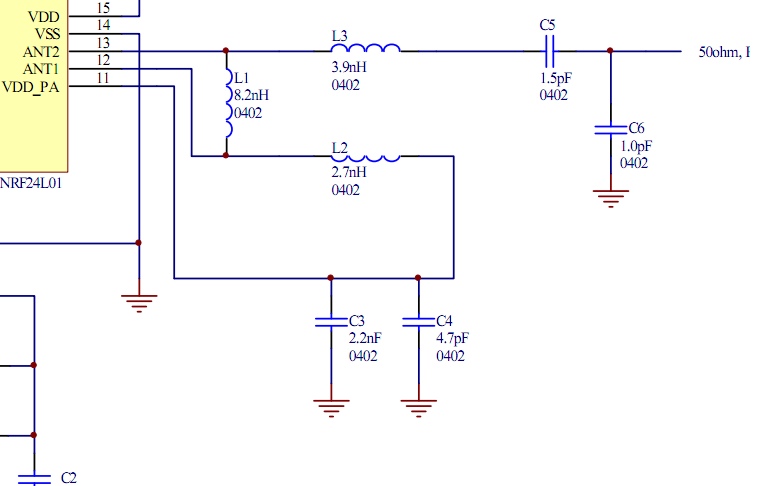
Multifunctional motor protection circuit
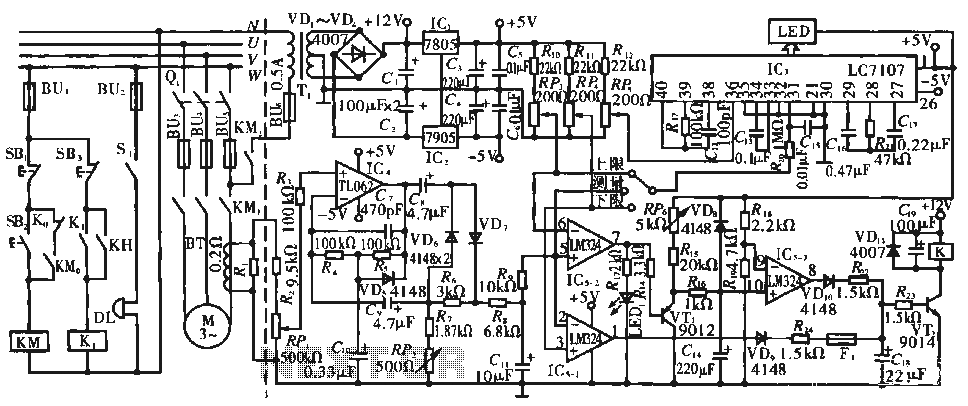
The circuit operates during standard inspection work by utilizing the voltage across resistor R2, which is connected to RP, to generate the input signal for IC4. Components R3 through Rg, along with capacitors C7 and C1, and diodes VD7 and VD6, facilitate the function of a half-wave rectified linear AC/DC converter amplifier. During the positive half-cycle, the signal flow is as follows: IC4 connects to CS, followed by VD7, R6, RP2, and GND. Conversely, during the negative half-cycle, the current discharges through the circuit in the sequence: GND, RP2, R7, VD6, Cs, and IC4. The output from R8, C1, and Rg provides an average RMS input voltage that is linearly proportional to the DC voltage. This voltage is fed into an A/D converter, which is calibrated using IC, R, and RP2 to accurately display the primary current of the current transformer in the BT. This circuit can be employed to protect three-phase AC electric motors by detecting the electrical circuit in any phase of the three-phase current.
The circuit's design is centered on monitoring and rectifying AC signals to provide a stable DC output suitable for further processing. The use of IC4 as a signal processor allows for effective signal conditioning, ensuring that the input from the resistive divider (R2 and RP) is accurately represented. The half-wave rectification process is critical for transforming the AC signal into a usable DC form, which is achieved through the action of diodes VD7 and VD6. These diodes only allow one polarity of the AC signal to pass, effectively blocking the negative half-cycle and enabling the circuit to utilize only the positive portion of the waveform.
The capacitors C7 and C1 play a crucial role in smoothing the rectified output, reducing ripple and providing a more stable DC voltage to the load. The resistors R3 to Rg are involved in setting the gain and establishing the reference voltage levels necessary for the A/D conversion process. The output at R8, along with the capacitors, ensures that the voltage remains within the acceptable range for the A/D converter, thus enabling accurate digital representation of the current being monitored.
This circuit is particularly useful in applications requiring precise current measurements in three-phase systems, such as electric motor protection. By continuously monitoring the current in each phase, the circuit can detect anomalies or faults, allowing for timely intervention to prevent damage to the motor. The inclusion of an LED display provides a visual indication of the current levels, making it easier for operators to assess the system's status at a glance. Overall, this design exemplifies a robust solution for current monitoring and motor protection in industrial applications.Circuit works: When normal inspection work where the voltage across the resistor R2 through, RP, partial pressure, as the input signal of IC4. IC4, R3 ~ Rg, C7 ~ ~ Cl ,, VDs VD, and the like mean response of a half-wave rectified linear AC / DC converter amplifier. Positive half cycle, signal flow is: IC4 a CS island a VD7- R6_ + _ + RP2- GND. The negative half cycle, the current discharge circuit is: GND- * RP2- R7- VD6_ Cs- lC4. Outputs R8, cl ,, Rg obtained an average RMS input linearly proportional DC voltage, the voltage by S.
(S. placed in normal operation measuring end) into the A / D converter is adjusted correctly IC ,, R) l and RP2, can accurately display LED current transformer primary current of BT. When used to protect the three-phase AC electric motor, which can be used to detect electrical circuit motive in any phase of the three-phase current.
The circuit's design is centered on monitoring and rectifying AC signals to provide a stable DC output suitable for further processing. The use of IC4 as a signal processor allows for effective signal conditioning, ensuring that the input from the resistive divider (R2 and RP) is accurately represented. The half-wave rectification process is critical for transforming the AC signal into a usable DC form, which is achieved through the action of diodes VD7 and VD6. These diodes only allow one polarity of the AC signal to pass, effectively blocking the negative half-cycle and enabling the circuit to utilize only the positive portion of the waveform.
The capacitors C7 and C1 play a crucial role in smoothing the rectified output, reducing ripple and providing a more stable DC voltage to the load. The resistors R3 to Rg are involved in setting the gain and establishing the reference voltage levels necessary for the A/D conversion process. The output at R8, along with the capacitors, ensures that the voltage remains within the acceptable range for the A/D converter, thus enabling accurate digital representation of the current being monitored.
This circuit is particularly useful in applications requiring precise current measurements in three-phase systems, such as electric motor protection. By continuously monitoring the current in each phase, the circuit can detect anomalies or faults, allowing for timely intervention to prevent damage to the motor. The inclusion of an LED display provides a visual indication of the current levels, making it easier for operators to assess the system's status at a glance. Overall, this design exemplifies a robust solution for current monitoring and motor protection in industrial applications.Circuit works: When normal inspection work where the voltage across the resistor R2 through, RP, partial pressure, as the input signal of IC4. IC4, R3 ~ Rg, C7 ~ ~ Cl ,, VDs VD, and the like mean response of a half-wave rectified linear AC / DC converter amplifier. Positive half cycle, signal flow is: IC4 a CS island a VD7- R6_ + _ + RP2- GND. The negative half cycle, the current discharge circuit is: GND- * RP2- R7- VD6_ Cs- lC4. Outputs R8, cl ,, Rg obtained an average RMS input linearly proportional DC voltage, the voltage by S.
(S. placed in normal operation measuring end) into the A / D converter is adjusted correctly IC ,, R) l and RP2, can accurately display LED current transformer primary current of BT. When used to protect the three-phase AC electric motor, which can be used to detect electrical circuit motive in any phase of the three-phase current.
